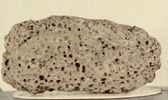
| The lunar samples on display at the National Air and Space Museum are representative of the basic types and ages of the rocks brought back from the Moon. The samples on display at the Museum are fragments of larger rock samples collected on the Moon by Apollo astronauts. All of the lunar rocks have been divided into pieces so that they may be studied. | |
|
|
Basalt |
| A basalt is a dark-colored fine-grained igneous rock rich in iron and magnesium. The "holes" visible in this lunar basalt sample are called vesicles, formed from tiny gas bubbles that were present when the molten rock cooled. Basalts are common rocks on Earth, so the question arises-Are Moon rocks very different from Earth rocks? | |
Photo credit: NASA Jump to pages: 1 | 2 | 3 | 4 | 5 | 6 | 7 | 8 |
|
